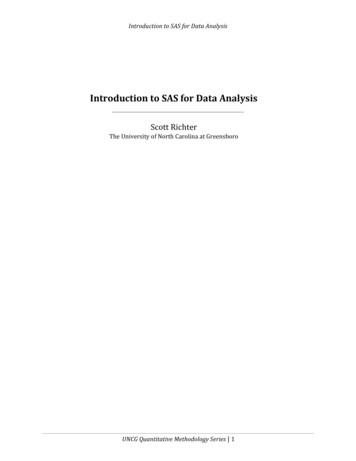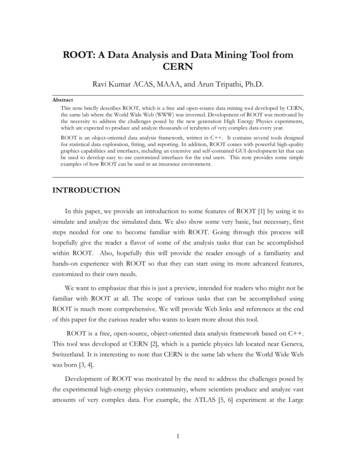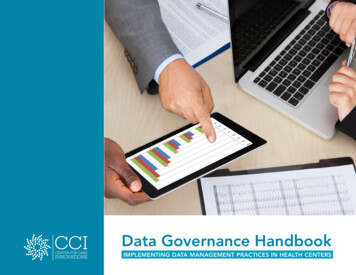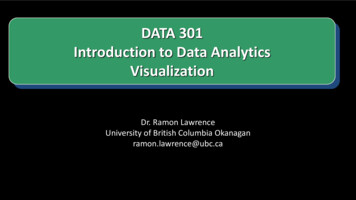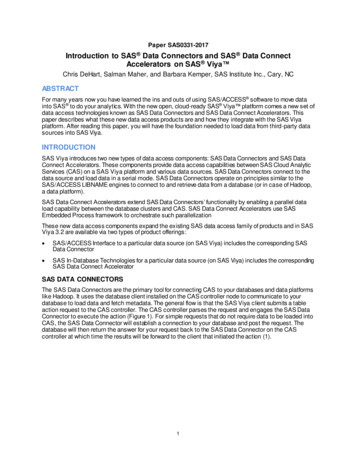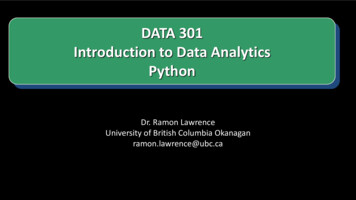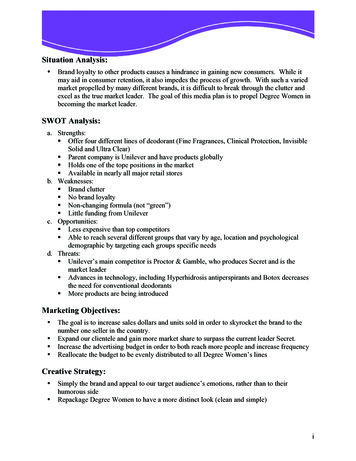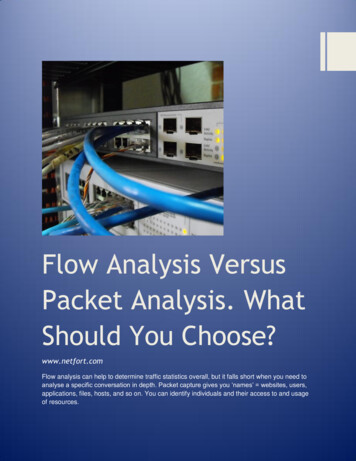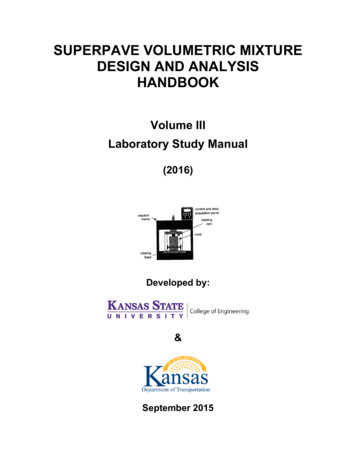
Transcription
Introduction toData AnalysisHandbook“IfI knew whatyou were going to usethe information forI would have done a betterjob of collecting it.”--Famous quote from a Migrant andSeasonal Head Start (MSHS) staffperson to MSHS director at aCommunity AssessmentTraining.Migrant & Seasonal Head StartTechnical Assistance CenterAcademy for Educational Development
AED’s Migrant and Seasonal Head StartTechnical Assistance Center (TAC-12)Mission StatementThe Migrant and Seasonal Head Start Technical Assistance Center (TAC-12) iscommitted to supporting Migrant and Seasonal Head Start programs in theircontinuing effort to provide the highest quality early childhood services to farmworker families. TAC-12 fosters quality technical assistance by capitalizing onstrengths and working collaboratively with programs.AED’s Center for Early Care and EducationMission StatementAED’s Center for Early Care and Education strives to enhance the lives of allunder represented, at-risk children and families through research, technicalassistance support, knowledge and provision of innovative strategies withinearly childhood programs throughout the United States. We are committedto supporting special populations within Head Start and the larger child carecommunity in their continual process to improve services to low-incomechildren and families. We strive to help all children enter school ready to learn.AcknowledgmentsThe development of this Handbook isan outcome of our work with Migrant andSeasonal Head Start programs across the country,particularly in the areas of community assessmentand child outcomes. Many programs expressed adesire to improve their abilities to more fully utilize thedata they collect. We are grateful to East Coast MigrantHead Start Project staff who provided important inputinto suggested content and format of this workbook at astaff training in November 2005. In addition we wantto thank Brian Richmond of the American IndianTechnical Assistance Network at AED for sharinghis knowledge by contributing AppendixB: Using Excel to Help Analyze YourQuantitative Data. AED/TAC-12 Spring 2006.
Introduction toData AnalysisHandbookMigrant & Seasonal Head StartTechnical Assistance CenterAcademy for Educational DevelopmentContract with DHHS/ACF/OHS/Migrant and Seasonal Program Branch AED/TAC-12 Spring 2006. Permission granted to copy for non-commercial uses only.
Table of ContentsI. Introduction. 1Introduction to the Handbook. 1Learning Objectives. 2Guiding Principles. 2What This Handbook Does Not Do. 2Why Do We Need Data Analysis?. 3II. Ways of Thinking About Data. 5Data is. 5Qualitative Data. 7Quantitative Data. 8Data Strategies. 9III. Conceptualizing Data Analysis as a Process. 13The “Problem” with Data Analysis. 13Data Analysis as a Linear Process. 14Data Analysis as a Cycle. 15IV. Managing the Data Analysis Process . 22Developing a Team. 22Planning. 24Data Management. 25Writing. 26Evaluation. 26Permission granted to copy for non-commercial uses only.
Table of Contents continuedV. Data Analysis Using Content Area Examples. 27Introduction to Data Analysis. 27Terms and Concepts. 29Data Procedures and Methods. 33Procedures for Quantitative Analysis. 33Methods for Qualitative Analysis. 37Content Area Examples Using DifferentProcedures and Methods. 40Health. 41Teacher Credentials. 43Classroom Quality. 47Disabilities. 57Estimating the Number of Eligible Migrantand Seasonal Head Start Childrenand Families. 60Infant Toddler Languages: Program Policies. 69Family Strengths and Needs. 75Appendix A: Foundations for Data AnalysisApplications in MSHS. 84Appendix B: Using Excel To Help Analyze YourQuantitative Date. 91Appendix C: Supplemental ResourcesScore Sheet: Early Childhood EnvironmentRating Scale - Revised. 96Data Analysis Evaluation Checklist. 103ii AED/TAC-12 Spring 2006.
I.IntroductionIntroduction to the HandbookThis Handbook provides an introduction to basic procedures and methods of dataanalysis. We provide a framework to guide program staff in their thinking about theseprocedures and methods and their relevant applications in MSHS settings. Accordingly,this Handbook was developed to support the work of MSHS staff across content areas.This Handbook was created because “using data in meaningful ways” includes manypossibilities – and a great deal of information. Some of this information is complex andhighly dependent upon specialized knowledge. However, there are many ways of “usingdata” that are more basic and that involve relatively simple procedures. Our purpose is toprovide MSHS programs with a basic framework for thinking about, working with, andultimately benefiting from an increased ability to use data for program purposes.Section I of the Handbook provides introductory information. Section I includes thepresentation of the “guiding principles” we use in presenting information, as well as thearticulation of specific learning objectives. In Section II, we present an introduction toways of thinking about data and make the distinction between two basic types of data:quantitative and qualitative. Section III outlines information that we hope will assistprogram staff understand how to conceptualize data collection and its analysis as aprocess. In Section IV we discuss management considerations that should be addressedin order to gather and analysis data in an efficient and effective way in your program. Wepresent a framework for managing the process of data collection and analysis. Becauseusing data for program purposes is a complex undertaking it calls for a process that isboth systematic and organized over time.In Section V of the Handbook we examine data analysis using examples of data fromeach of the Head Start content areas. We explore examples of how data analysis could bedone. We identify and describe trends in data that programs collect. Finally, we offer aperspective of how data lends itself to different levels of analysis: for example, granteewide, by delegate agency, and/or center- or classroom-level. Our intent is to demonstratehow the different analytical procedures and methods can be powerful and effective toolsfor MSHS managers. Specific procedures and methods of data analysis are discussed withclear ways of using and working with data in order to identify results. Here, proceduresand methods for working with both quantitative and qualitative data are presented. AED/TAC-12 Spring 2006. Permission granted to copy for non-commercial uses only.
Learning ObjectivesThis Handbook is used in training sessions offered by the Migrant and Seasonal HeadStart Technical Assistance Center (TAC-12). It can also be used as a self-paced or groupresource. Utilizing this Handbook, you will explore how to: use a wide variety of data for planning and decision-making purposes; begin to develop abilities to use data to describe program operations and/or practices; observe basic techniques of data analysis to real-life Head Start examples; and identify and articulate trends and patterns in data gathered over time.Guiding Principles for Approaching Data Analysis1. To provide information to program staff from a variety of different backgrounds and levels ofprior experience.2. To create a “value-added” framework that presents strategies, concepts, procedures,methodsand techniques in the context of real-life examples.3. To appreciate that learning takes time.4. Comfort, confidence, and competence take practice.5. Data analysis provides opportunities to “reduce the burden.”What This Handbook Does NOT DoThis Handbook does not provide guidance on data collection. For those who are familiarwith the Five Steps to Community Assessment: A Model for Migrant and Seasonal HeadStart programs workbook, that resource can provide you with good strategies for datacollection.In addition, this Handbook does NOT attempt to address all possible procedures ormethods of data analysis or imply that “data analysis” is limited to the contents of thisHandbook. Program staff are urged to view this Handbook as a beginning resource, andto supplement their knowledge of data analysis procedures and methods over time as partof their on-going professional development. In addition, fiscal analysis procedures such asanalyzing cost per child per hour, etc are beyond the scope of this handbook. AED/TAC-12 Spring 2006. Permission granted to copy for non-commercial uses only.
This Handbook does not provide information on how to complete the ProgramInformation Report (PIR). This information is provided by the PIR contractor, Xtria, inthe form of an annual User’s Guide (see www.xtria.com/pir2005). Programs who requireassistance in completing the PIR are instructed to contact their designated ProgramSpecialist.This Handbook does not teach how to use Excel or other spreadsheet programs. Trainingon data entry, use of spreadsheets, and other applications is available from a variety ofsources. Suggestions are included in Appendix B.Finally, we cannot answer questions about how Head Start program monitoring willbe conducted in the future, including which types of data will be gathered and used inprogram reviews.Why Do We Need Data Analysis?Data is short hand for “information,” and whether you are collecting, reviewing, and/or analyzing data this process has always been part of Head Start program operations.Children’s enrollment into the program requires many pieces of information. Theprovision of health and dental services includes information from screening and anyfollow-up services that are provided. All areas of a Head Start program – content andmanagement – involve the collection and use of substantial amounts of information. ForMSHS programs, the use of data becomes even more crucial, as essential informationmust be managed within relatively short program seasons. Very few people working inMSHS programs complain about not having enough to do!In addition, Head Start program operations have evolved substantially over the last tenyears. As new requirements have been added, and new program initiatives launched,programs are increasingly expected to use data in meaningful ways. Finally, if the PRISMprocess will “focus on the collection, reporting, and analysis of data,” programs are welladvised to develop their expertise in working with data.Lastly, recent Head Start sources support the need for a better understanding of dataanalysis in our work. AED/TAC-12 Spring 2006. Permission granted to copy for non-commercial uses only.
From the Head Start Bureau website (October 4, 2005):The Head Start Bureau has made some significant changes to procedures guiding theFY 2006 PRISM. The changes will affect areas such as on-site review, the relationshipbetween Federal team leaders and home region, and the way grantee and delegate agencyreviews are conducted. The new changes to be implemented will also impact the PRISMInstrument procedures for reviewing service areas. An increased emphasis will focus onthe collection, reporting, and analysis of data.From Information Memorandum ACYF-IM-HS-05-08 (10/04/05):Changes to the PRISM ProcessThe following changes to the PRISM process are in place for fiscal year 2006:The on-site review will focus on the collection, reporting, and analysis of data. Thegrantee presentation and summary meeting will no longer occur.Federal team leaders will not supervise reviews in their home region when conductingtriennial and first year reviews. These team leaders will, however, continue to supervisefollow-up reviews for grantees in the Federal team leader’s home region.For grantees with delegate agencies, each delegate agency will be reviewed concurrentlywith the grantee agency review as part of each triennial and first-year m05/im05 08.htm AED/TAC-12 Spring 2006. Permission granted to copy for non-commercial uses only.
II. Ways of Thinking About DataData is The 1973 Webster’s New Collegiate Dictionary defines data as “factual information (asmeasurements or statistics) used as a basis for reasoning, discussion, or calculation.” The1996 Webster’s II New Riverside Dictionary Revised Edition defines data as “information,especially information organized for analysis.” Merriam Webster Online Dictionarydefines data” as the following (http://www.m-w.com):1 : factual information (as measurements or statistics) used as a basis for reasoning,discussion, or calculation. E.g., the data is plentiful and easily available -- H. A.Gleason, Jr., e.g., comprehensive data on economic growth have been published-- N. H. Jacoby.2 : information output by a sensing device or organ that includes both useful andirrelevant or redundant information and must be processed to be meaningful.3 : information in numerical form that can be digitally transmitted or processed.Taking from the above definitions, a practical approach to defining data is that datais numbers, characters, images, or other method of recording, in a form which can beassessed to make a determination or decision about a specific action. Many believethat data on its own has no meaning, only when interpreted does it take on meaningand become information. By closely examining data we can find patterns to perceiveinformation, and then information can be used to enhance knowledge (The Free On-lineDictionary of Computing, 1993-2005 Denis Howe). The number 1,099 is one example of data. “The number of children who were determined to have a disabilityprior to enrollment in Migrant and Seasonal Head Start for the 2004enrollment year is 1,099” is information. AED/Tac-12 Spring 2006. Permission granted to copy for non-commercial uses only.
What has been evident in disciplines such as education, public health, nutrition, nursing,and management, is now becoming evident in early care and education, including HeadStart. Programs now recognize that the quality and quantity of data, be it statistical ordescriptive, is needed to set baselines, identify effective actions, set goals and targets,monitor progress and evaluate impacts (World Bank Website html).One thing that Migrant and Seasonal Head Start programs can do well is gather data.Using an upstream program as an example, in late May the data gathering process is swiftand fast during enrollment. If the data relates to a child or family it is shared amongappropriate Head Start staff. When the program ends, the data is stored, and next thingyou know it is March and the program is preparing for pre-service. The question thatone is always left with is: what do we do with all this data and or information? One of thegoals of this handbook is to help you answer this question.Before you can present and interpret information, there must be a process for gatheringand sorting data. Once again, 1,099 is a number - and this number is, in fact, data. Thenumber 1,099 is a raw number - on its own it has no meaning. Just like many of the cropsthat our families pick are raw from which food is prepared, so too, can data be viewed asthe raw material from which information is obtained.Head Start requires the collection of data in a variety of areas. We collect data in allof the content service areas. Thus, data collection is something that is not just limitedto children and families, but if the purpose and the questions relate to children andfamilies it is definitely not good practice to collect data when the children and familiesare not available. The data you collect in Head Start can take many forms. The datacould be in the form of numbers, words, pictures, maps, and even newspaper articles.When collecting data, we are faced with the inevitable question of which is better. Theconcept of which is better has the potential to lead to the qualitative versus quantitativedebate, which although exhilarating to some, could cause havoc in program planning andimplementation. These debates fail to achieve an honest understanding of how qualitativeand quantitative data differ, because in many people’s mind the difference between thetwo is underscored by the notion that one is better than the other.Why the Soliloquy? Types of DataIn research circles there has been a long-term debate over the merits of Quantitativeversus Qualitative data. Key influences in this debate are based upon how researcherswere taught, compounded by differences among individuals and their preference inrelating to numbers or to words.In reality, this debate is largely irrelevant in Head Start. In order to have a high qualityprogram, we must collect both types of data. There are times when a quantitative AED/TAC-12 Spring 2006. Permission granted to copy for non-commerical uses only.
approach will be better suited to the situation and vice versa. “Qualitative and quantitativemethods are not simply different ways of doing the same thing. Instead, they havedifferent strengths and logics and are often best used to address different questions andpurposes (Maxwell, 1996,2005).” That being said, there are other times when it makessense to “have the best of both worlds,” and to use a combination of some quantitativeand some qualitative data in order to credibly address a particular question and make wellinformed decisions.Qualitative dataData that is represented either in a verbal or narrative format is qualitative data. Thesetypes of data are collected through focus groups, interviews, opened ended questionnaireitems, and other less structured situations. A simple way to look at qualitative data isto think of qualitative data in the form of words. Later on, we will explore how thetranscript below can be used as a source of data.Sample Qualitative Data: Transcript from Parent Interview(Family One – husband)OK, well, me first, before anything, I came here because of the poverty, do youunderstand me? And for a good quality of life, in my country not so much thinkingabout myself but about my smaller sisters so that they can have a better educationconsidering that I did not have any, and another reason was in my country there areno good jobs, and very little work. They pay you very little and you never leave thepoverty and another reason is that my father had two brothers that were already hereand I thought that the more of us that are here the better that everybody could helpeach other out and it would be easier to get ahead with our younger sisters.(Family One – wife)The same to help my parents I came and I would send money and then my brothercame and then the same.(Family One – husband)Because in her case, she or better yet sometimes us (in our situation) because we werethe eldest, we were men but in her case the eldest are women, and the ones that weregoing to work, theoretically to help the parents the most were the youngest.(Family One-wife)My dad was already here when I came, he was here, my mother was in Mexico, mydad stayed here for some time and then he went to Mexico. AED/Tac-12 Spring 2006. Permission granted to copy for non-commercial uses only.
(Family One-husband)More than anything, my parents for example they are that type of people that supportyou no they never stop, for example your dreams do not become reality they alwaystry that if you decide, you know who you are, and they always let us what we wantedbetter yet things that they showed us and that were good we would do them and theyalways tried to better us.Quantitative dataQuantitative data is data that is expressed in numerical terms, in which thenumeric values could be large or small. Numerical values may correspond to aspecific category or label.Sample Quantitative Data from PIRActual Enrollment by ChildAges of children served:a. Under 1 year:. 3,843b. 1 Year old:. 4,785c. 2 Years old:. 6,341d. 3 Years old:. 7,604e. 4 years old:. 6,988f. 5 Years and older:. 3,462Contrasting Types of Data in Head Start Qualitative DataFamily Partnership AgreementsSocial Service logsAdvisory group minutesPolicy Council minutesNewspaper articlesQuantitativePIRChild performance trackingHealth data tracking systemsMixed DataEnrollment infoEnrollment & transition recordsSurveys (i.e., Parent, Teacher/Staff,Farmer) AED/TAC-12 Spring 2006. Permission granted to copy for non-commerical uses only.
Data StrategiesThere are a variety of strategies for quantitative and qualitative analyses, many of whichgo well beyond the scope of an introductory Handbook. Different strategies providedata analysts with an organized approach to working with data; they enable the analystto create a “logical sequence” for the use of different procedures. In the boxes below,we offer four examples of strategies for quantitative analysis that you may consider asyou work with and develop your skills in data analysis as well as reasons why you mayconsider using the strategy. Some of these strategies are used in Section V when lookingat particular content area data.Strategy: Visualizing the DataInvolves: Creating a visual “picture” or graphic display of the data.Reason(s): a way to begin the analysis process; or as an aid to the reporting/presentation of findings.Strategy: Exploratory AnalysesInvolves: Looking at data to identify or describe “what’s going on”? – creating aninitial starting point (baseline) for future analysis.Reason(s): Like you have a choice?Strategy: Trend AnalysisInvolves: Looking at data collected at different periods of time.Reason(s): to identify and interpret (and, potentially, estimate) change.Strategy: EstimationInvolves: Using actual data values to predict a future value.Reason(s): to combat boredom after you have mastered all the previous strategies.Also to answer PIR and Community Assessment items and tasks. AED/Tac-12 Spring 2006. Permission granted to copy for non-commercial uses only.
Visualizing DataVisualizing data is to literally create and then consider a visual display of data. Technically,it is not analysis, nor is it a substitute for analysis. However, visualizing data can be auseful starting point prior to the analysis of data.Consider, for example, someone who is interested in understanding Migrant and SeasonalHead Start from a national perspective. Specifically, someone might be interested in thedifferences in funded enrollment across all MSHS grantees. Looking at a random list offunded enrollmment numbers (PIR, 2004) gives us one perspective:Random List of Funded 23776018307543914254701762274684701332216In random order, it is a bit difficult to get a handle on the data. By ranking the values inorder however (notes: this can be done either lowest to highest or highest to lowest) wegain a more organized perspective of the data set:10 AED/TAC-12 Spring 2006. Permission granted to copy for non-commerical uses only.
Rank Order of Funded 4806776847548301601176222162709271969848623MSHS: Funded EnrollmentGranteeMSHS: FUNDEDbyENROLLMENTBY2004GRANTEE2004100009000NUMBER OF CHILDREN 67891011121314151617181920212223242526GRANTEE AED/Tac-12 Spring 2006. Permission granted to copy for non-commercial uses only.11
By creating a visual display of the data, we can begin to get a “feel” of how MSHS granteesdiffered in terms of their funded enrollment in 2004 using the numbers above (Note: InExcel, go to “Insert” and select “Chart” to convert a spreadsheet column into a bar chart,see Appendix B.).By creating and viewing a graphic display of the data, we get a “feel” of how MSHSgrantees’ funded enrollment varies across the region. In particular, the size differencesbetween the two largest grantees and the rest of the region stand out, as do the morebasic differences between “small” and “large” programs. Again, this visual display of datais not a substitute for analysis, but it can often provide an effective foundation to guidesubsequent analyses.Exploratory AnalysisExploratory analysis entails looking at data when there is a low level of knowledge abouta particular indicator (teacher qualifications, first and second language acquisition, etc.)It could also include the relationship between indicators and/or what is the cause of aparticular indicator.Trend AnalysisThe most general goal of trend analysis is to look at data over time. For example, todecern whether a given indicator such as the number of children with disabilities hasincreased or decreased over time, and if it has, how quickly or slowly the increase ordecrease has occurred. One aspect of trend analysis that is discussed in this Handbookand encouraged is that of comparing one time period to another time period. This formof trend analysis is carried out in order to assess the level of an indicator before and afteran event.EstimationEstimation procedures may occur when working with either quantitative or qualitativedata. The use of both quantitative data such as poverty level data, can be combined withinterviews from providers serving low income families to help determine the proportionof families in the area that are income eligible. Estimation is one of many tools used toassist planning for the future. Estimation works well for forecasting quantities that areclosely related to demographic characteristics, eligible children and families, and socialservices. Estimation is the combination of information from different data sources toproject information not available in any one source by itself.12 AED/TAC-12 Spring 2006. Permission granted to copy for non-commerical uses only.
III. Conceptualizing Data Analysisas a ProcessThe “Problem” with Data AnalysisWhat does ‘data analysis’ mean? Does it refer to one method or many? A collection ofdifferent procedures? Is it a process? If so, what does that mean? More important, canMSHS program staff – without a background in math or statistics – learn to identify anduse data analysis in their work? (P.S. - the answer to the last question is Yes! – assuming aminimum investment of time, effort, and practice).Data analysis can refer to a variety of specific procedures and methods. However, beforeprograms can effectively use these procedures and methods, we believe it is important tosee data analysis as part of a process. By this, we mean that data analysis involves goals;relationships; decision making; and ideas, in addition to working with the actual dataitself. Simply put, data analysis includes ways of working with information (data) tosupport the work, goals and plans of your program or agency.From this perspective, we present a data analysis process that includes the following keycomponents: Purpose Questions Data Collection Data Analysis Procedures and Methods Interpretation/Identification of Findings Writing, Reporting, and Dissemination; and EvaluationWe have also found, from our review of the literature, that there are many different waysof conceptualizing the data analysis process. We can make a basic distinction between alinear approach and a cyclical approach; in this Handbook we provide examples of both. AED/TAC-12 Spring 2006. Permission granted to copy for non-commercial uses only.13
Data Analysis as a Linear ProcessA strictly linear approach to data analysis is to work through the components in order,from beginning to end. A possible advantage of this approach is that it is structured andorganized, as the steps of the process are arranged in a fixed order. In addition, this linearconceptualization of the process may make it easier to learn. A possible disadvantage isthat the step-by-step nature of the decision making may obscure or limit the power of theanalyses – in other words, the structured nature of the process limits its effectiveness.14 A
methods of data analysis or imply that “data analysis” is limited to the contents of this Handbook. Program staff are urged to view this Handbook as a beginning resource, and to supplement their knowledge of data analysis procedures and methods over
